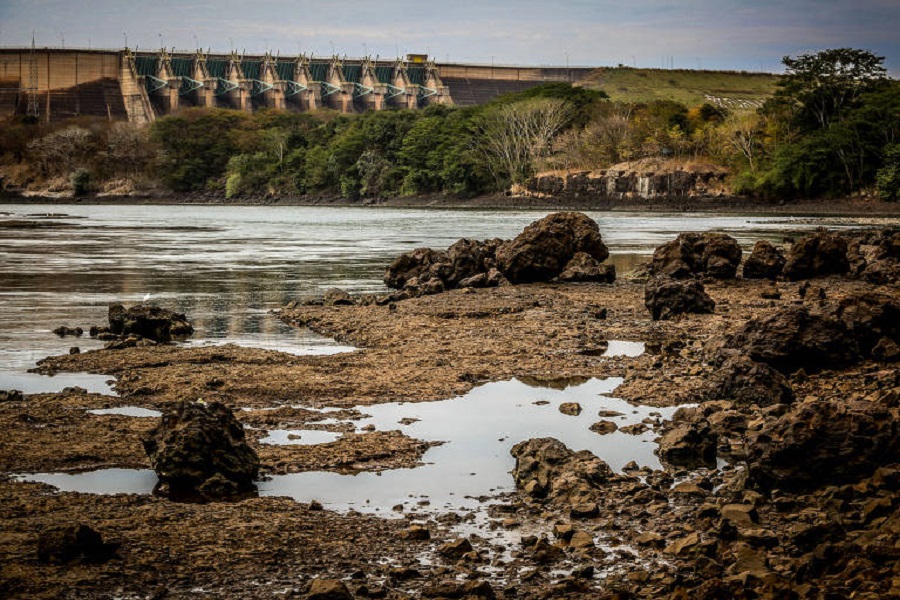RIO DE JANEIRO, BRAZIL – National Institute of Meteorology’s (INMET) specialists are relying on the return of rainfall at the end of September in Brazil’s center-south, where this year’s drought has placed hydroelectric power plant reservoirs on alert.
The potential impact of the La Niña climate phenomenon, starting in October, could reduce rainfall by 10% to 30% in the region.

The phenomenon causes a periodic change in the temperature of Pacific Ocean waters, which tends to reduce rainfall in Brazil’s center-south, exacerbating the drought in the Paraná River basin.
The concern is that this will occur again at the very beginning of this year’s rainy season, which would further hinder the recovery of the reservoirs’ capacity in the region.
According to the ONS (National Electric System Operator), the reservoirs of plants in the Southeast/Midwest subsystem have been operating at critical levels for months, and the crisis in the national electric system is worrying analysts.
Data from INMET shows that the states of São Paulo and Paraná have seen below average rainfall since January. During all months this year through July, most states saw a lower volume of rainfall than in the same period last year.
According to the institute’s meteorologist Cleber Souza there are positive signs of recent rainfall in the South region. Although no above average rainfall is expected for the coming months, the return of rain in the Southeast and Midwest in the second half of September would relieve both farmers and the electricity system.
“It is difficult to accurately forecast the exact impact of La Niña on this year’s rainfall, but it is a phenomenon that weakens cold fronts and is undoubtedly a source of concern,” Souza says.
The energy risk scenario also worries economists, who are starting to anticipate the effects of the lack of water on economic recovery.
Brazil may enter a scenario of stagflation (economic stagnation with inflation), should the rainfall fail to return in the fourth quarter, according to RPS Capital’s chief economist Gabriel Leal de Barros.
In his opinion, the government has changed its stance and now recognizes that the electric sector’s situation is dramatic. “What worries us, in addition to the water situation, is the future increase of the most expensive tariffs by ANEEL (National Electric Energy Agency),” he says.
According to Barros, in order not to disrupt the electrical sector and increase the deficit in the cost of thermal plants, the new flag tariff will be important to define the impact of energy prices on next year’s inflation.
According to Roberto Wagner Pereira, energy specialist at CNI (National Confederation of Industry), the possible measures to reduce the impact of the shortage of rain in the sector are now on the table, such as hiring more thermal plants and promoting a voluntary program to reduce use.
“We hope that they will work and that we will get through this comfortably. I don’t see a risk of a blackout today, but there is an obvious risk of rationing and we hope that this will be enough,” he says.
The lower volume of rainfall also worries rural producers and investors in agricultural commodities, says ACREFI’s (National Association of Credit, Financing and Investment Institutions) economic consultant Nicola Tingas.
There is an environment of deteriorating economic conditions, affecting everything from the production of manufactured goods to agriculture, which is also likely to experience crop losses, he says. According to him, with supply problems, there may be a further increase in inflation. “The overall scenario reduces the motivation to invest and there is a slowdown in the pace of economic recovery, with risks that prevent a higher investment rate.”
He also believes that the government could have been quicker in the measures taken to solve the crisis. “Ideally, some actions should have been anticipated – and the problem now may be bigger than we would like,” he says.
In this scenario, the Gross Domestic Product (GDP) of farming and livestock should grow less this year, according to IPEA (Institute for Applied Economic Research), which cut its estimate for the indicator in 2021, from 2.6% to 1.7%.
“The worst is the lack of structured planning for the medium and long term, since climate change tends to make this a frequent problem,” says IEDI’s (Institute for Industrial Development Studies) Rafael Cagnin.
He says that the use of thermoelectric plants is reasonable to overcome the immediate challenge, but it is not a final solution, because it is more expensive, more prone to exchange rate variations and, above all, incompatible with the environment.
“This water crisis is not a challenge only for 2021, but how we are going to deal with it determines whether or not we understand the environmental emergency,” the economist says.

